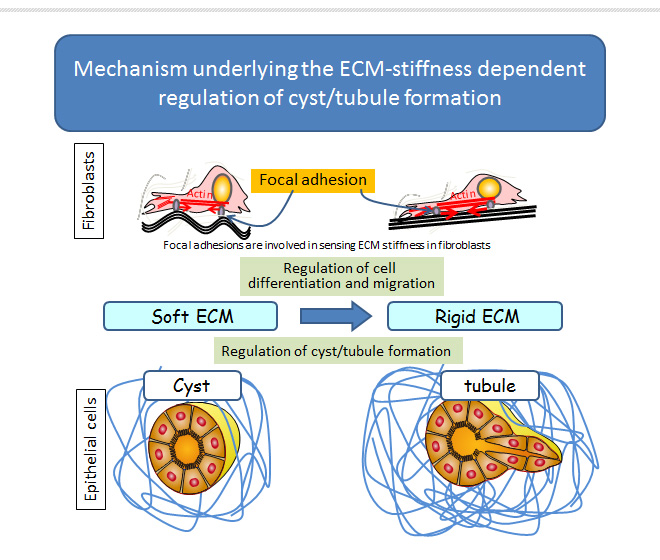|
HOME > Proposed research projects > 2014-2015: Proposed research projects 03
 2014-2015: Proposed research project 03Molecular mechanisms by which stiffness of extracellular matrix regulates the formation of epithelial tubular structure
Purpose of the Research ProjectCells are surrounded by extracellular matrix, including collagen and fibronectin. It is well established that microenvironment of cells, such as a variety of extracellular matrix, regulates cellular function and behaviors. Recent evidences have indicated that stiffness of extracellular matrix also works as crucial cues to control cell behaviors. One important example is tubular structure formation of epithelial cells. Mammary epithelial cells form cysts in soft collagen gels but tubular structures in rigid gels. Cell-extracellular matrix adhesion sites, focal adhesions, play a critical role in sensing stiffness of the extracellular matrix in mesenchymal cells. Cells pull the extracellular matrix through focal adhesions using intracellular tension generated by actomyosin and adjust the tension to the stiffness accordingly, leading to “sensing” the stiffness of extracellular matrix. Although some molecules are suggested to be involved in this process in mesenchymal cells, molecular mechanisms underlying the sensing the stiffness of extracellular matrix in epithelial cells are largely unknown. Content of the Research ProjectTo clarify molecules playing roles in sensing the stiffness of extracellular matrix and regulating the cyst and tubule formation, we will examine the function of focal adhesion proteins in epithelial cells using 3D collagen-gel culture system and hydrogel culture system. These culture systems are suitable for modulating the stiffness of extracellular matrix. This project will contribute to understand the molecular mechanisms by which stiffness of extracellular matrix directs cyst and tubule formation of epithelial cells. Expected Research Achievements and Scientific SignificanceSeveral adaptor-type focal adhesion proteins, including talin and p130CAS, have been suggested to work as mechanosensors for intracellular tension in in vitro system or in fibroblasts. We have recently shown that other adaptor-type focal adhesion proteins, vinculin and vinexin, play important roles in sensing stiffness of the extracellular matrix and regulating stiffness-dependent cell migration in fibroblast cells. Progress in this new research will provide an important information on mechanosensors in epithelial cells. This would enable us not only to clarify the novel mechanism to control cyst and tubule formation of epithelial cells but also to compare the molecular mechanisms of sensing the stiffness of extracellular matrix in mesenchymal and epithelial cells.
|








